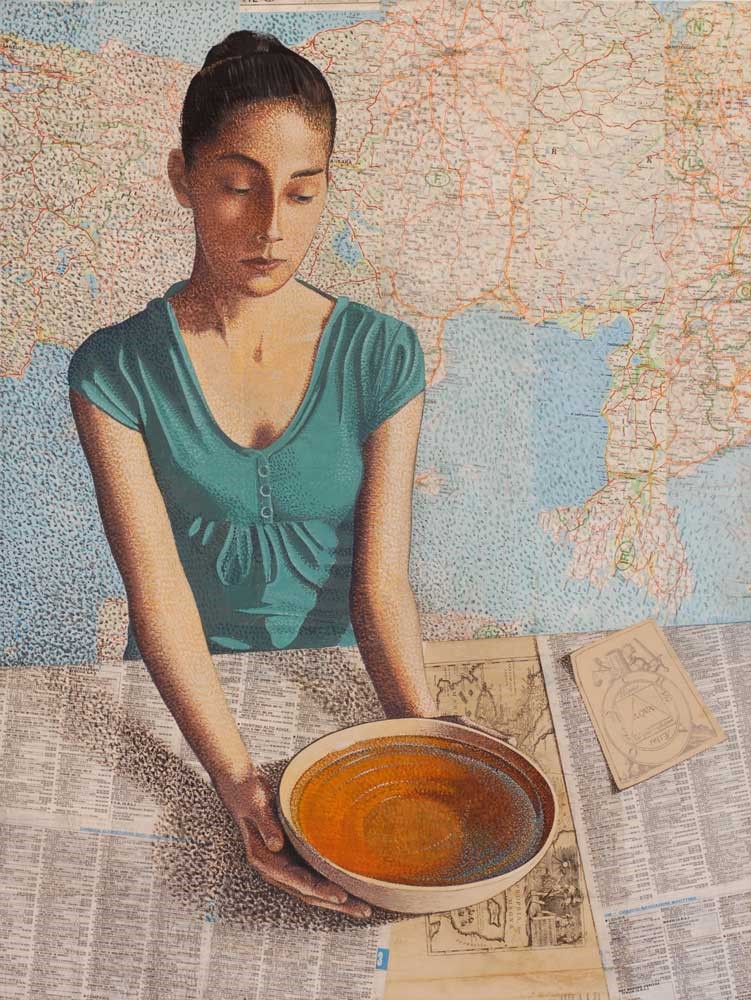
Acua Mater
Enrico Versari, ovvero l’amore salvifico. Arturo Schwarz
Enrico Versari, ovvero l’amore salvifico.
Nella volgarità, vacuità e ripetitività di una pseudo avanguardia “post moderna” (Damien Hirst, ad esempio), si distingue l’opera erudita di un artista autentico, Enrico Versari. Per trasmettere un profondo messaggio umanistico egli non esita a utilizzare i mezzi più tradizionali (olio o tempera e collage) superando quanto egli stesso ritiene essere “un realismo ingenuo.” Egli approda così ad un realismo romantico, e quindi iniziatico espresso attraverso il ritorno al ritmo del disegno. Disegno che è per lui “un mezzo semplice, sottovoce […] ottimo strumento di indagine filosofica” che si contrappone “al frastuono virtuale e veloce della contemporaneità”. Così, egli confessa la sua ambizione di evocare – sfruttando la memoria del soggetto – “con poche linee ben scelte un tutto*.” (Il corsivo è mio). Ma questo, egli continua, “non per la creazione di un bello effimero ma per uno studio filosofico su ciò che appare, per insegnarci a gettare un nuovo sguardo sulle solite cose”. In proposito mi si lasci commentare una delle sue ultime opere (del 2011): una tempera e collage su tavola intitolata Aqua Mater. Tra tante altre che mi hanno ugualmente colpito, quest’ultima si presta eccellentemente a rivendicare la dimensione filosofica del suo lavoro.
Negli ultimi quattro anni, per creare lo sfondo dell’opera, egli ha incollato –su tela o tavola – vecchi elenchi telefonici, vocabolari, mappe geografiche ecc., carte dimenticate e ormai inutili ma, come egli scrive, “nobilitate dalla pittura con la quale interagiscono”. Per Acqua Mater le carte geografiche, che ne costituiscono il fondo, sono state ritagliate per rappresentare un mondo senza confini dove il concetto di distanza “ha perso ogni valore,” come precisa l’autore.
In primo piano una giovane donna offre allo spettatore, con un gesto ieratico, acqua in una ciotola di terracotta. Il piano del tavolo sul quale poggia la ciotola è, a sua volta, rivestito con pagine di un elenco telefonico e di un’atlante terra-cielo immaginario. La successione dei nomi, così come le carte topografiche, suggeriscono che il dono dell’acqua è destinato all’umanità intera.
Soffermiamoci, per concludere questa nota, sul significato archetipico dell’acqua per capire la valenza simbolica di questo dono. Anzitutto rileviamo che il simbolo alchemico dell’acqua è un triangolo il cui vertice punta verso il basso. Non è certo una coincidenza se questa figura geometrica – che evoca il pube – rimandi anche al femminile e con lei ai suoi aspetti salvifici. Non dimentichiamolo, Afrodite (dea dell’amore e della bellezza) è emersa nuda dall’acqua del mare e lo stesso suo nome significa, in greco antico, “nata dalla schiuma”. È forse necessario ricordare che l’amore (pathos) in greco antico è lo strumento salvifico e iniziatico per eccellenza?
Per Empedocle era un fattore cosmologico primario e lo stesso divenire era determinato dalla dialettica amore/odio. Per Spinoza – per me il più fondamentale filosofo di tutti i tempi – l’amore conduceva all’unità-totalità perfetta e compiuta. Non soltanto questo sentimento permetteva il passaggio da una minore perfezione ad una maggiore: “l’amore rende migliore, fortifica e accresca ciò che è perfezione” ma era addirittura “il fondamento di ogni bene” .
L’acqua è – assieme alla terra, al fuoco e all’aria – uno dei 4 elementi primari dell’antica cosmogonia greca. Ad essa – ulteriore rimando al femminile – è associata l’emozione e l’intuizione. Due qualità tipicamente femminili in opposizione al pragmatismo e al razionalismo tradizionalmente considerate virtù maschili.
Infine, nell’immaginario collettivo – come rivela la letteratura psicanalitica – l’acqua sta per la parte più profonda della personalità – l’inconscio ed è un allegoria del tempo, dell’eterna giovinezza (la fontaine de jouvence). Nel mito omerico ha una valenza cosmogonica: la creazione dell’universo è associata all’Oceano.
Arturo Schwarz
“Enrico Versari, La forma dell’invisibile”, Tipografia Faentina Editrice, 2011.
Enrico Versari, or rather the redeeming love
Among the vulgarity, vacuity and repetitiveness of pseudo avant-garde “post modern” art (for example Damien Hirst), the erudite work of an authentic artist, Enrico Versari, stands out.
He does not hesitate to use the most traditional means (oil or tempera and collage) to communicate a deeply humanistic message, going beyond what he himself considers “a naïve realism”. He arrives at a romantic realism, and so initiation expressed through the return to the rhythm of design. Design which for him is “a simple means, soft […] an excellent instrument for philosophical inquiry” which is in contrast “to the virtual and frenetic din of contemporaneity”.
So he confesses his ambition to evoke – taking advantage of the memory of the subject – “with a few well-chosen lines to create a totality*.” (the italics are mine). But this, he continues, “not for the creation of an ephemeral beauty but for a philosophical study on that which appears, to teach us to take a new look at the usual things”. Allow me to comment on one of his recent works (from 2011) to illustrate: a tempera painting and collage entitled Aqua Mater. Among the many others which all had a profound affect on me, this piece is perfect for asserting the philosophical dimension of his work.
Over the last four years, to create the background of the work, he has stuck – on canvas or wood – old phone books, dictionaries, maps etc., forgotten or unused pages, as he writes, “dignified by the painting with which they interact”. For Aqua Mater, the maps which make up the background were cut out to represent a world without borders where the concept of distance “has lost all value,” as the author states.
In the foreground we see a young woman offering the spectator water in a terracotta bowl with a hieratic gesture. The table top where the bowl rests is covered in pages from a telephone directory and an imaginary map showing land and sea. The list of names suggests, as do the maps, that the gift of water is meant for the whole of humanity.
Let us focus on the archetypal significance of water to conclude this analysis and understand the symbolic worth of this gift. First of all we must remember that the symbol in alchemy for water is a downward-pointing triangle. It is certainly no coincidence if this geometric shape – which is reminiscent of the pubic area – is associated with woman and her redeeming aspects. Let us not forget Aphrodite (Goddess of love and beauty), who came out of the water naked and whose name in Ancient Greek means, “born from the sea foam”. Perhaps it is necessary to remember that love (pathos) in Ancient Greek is the instrument of redemption and initiation par excellence.
For Empedocles it was a key cosmological factor and its becoming was determined by the love/hate dialectics. For Spinoza – in my opinion the most fundamental philosopher of all time – love leads to perfect and complete unity-totality. Non only did this emotion allow a transition from a minor perfection to a major one: “love makes better, stronger and expands that which is perfection” but it was also “the foundation of all good” .
Water is – together with earth, wind and fire – one of the 4 primary elements of Ancient Greek cosmogony. In another reference to the feminine, emotion and intuition are associated to this. Two typically feminine qualities in opposition to pragmatism and rationalism traditionally considered male virtues.
Finally, in the collective imagination – as revealed by psychoanalytic literature – water represents the deepest part of the personality – the unconscious and it is an allegory of time, of eternal youth (the Fountain of Youth). In the Homeric myth it has a cosmogonic worth: the creation of the universe is associated to the Ocean.
Arturo Schwarz
“Enrico Versari, La forma dell’invisibile”, Tipografia Faentina Editrice, 2011.
Leave a Reply
You must be logged in to post a comment.
